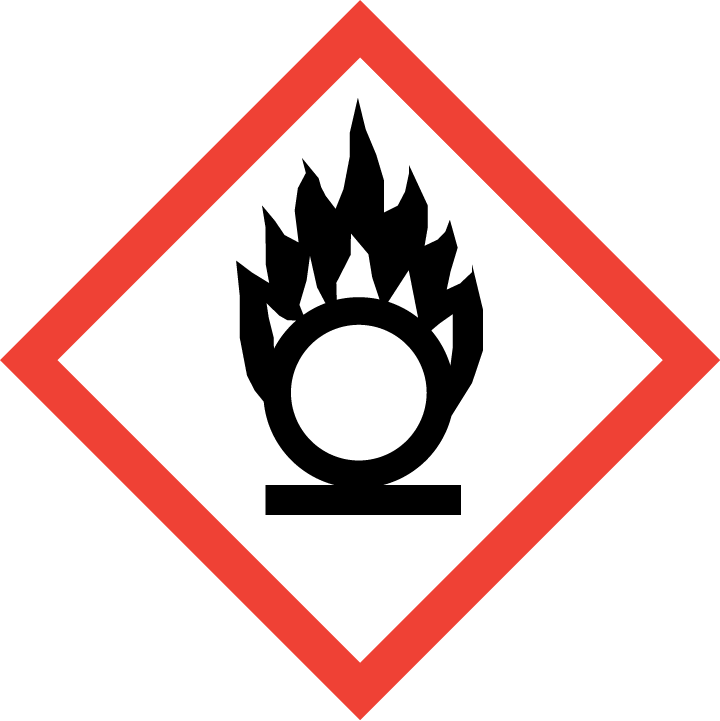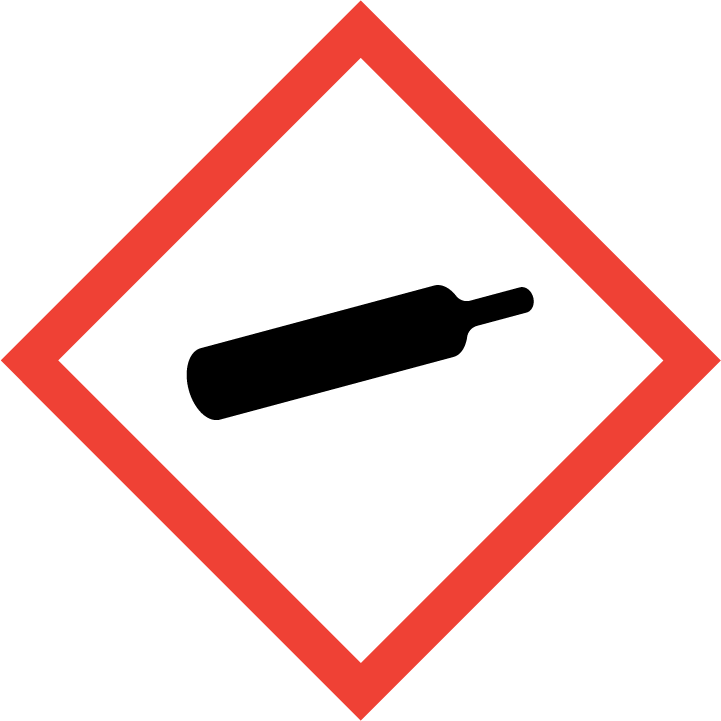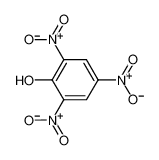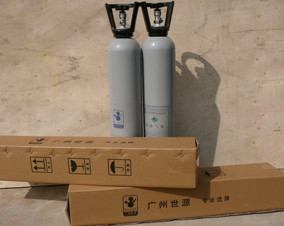1.Identification
1.1 GHS Product identifier
| Product name | nitrogen dioxide |
|---|
1.2 Other means of identification
| Product number | - |
|---|---|
| Other names | nitrogen(IV) oxide |
1.3 Recommended use of the chemical and restrictions on use
| Identified uses | For industry use only. |
|---|---|
| Uses advised against | no data available |
1.4 Supplier's details
| Company | MOLBASE (Shanghai) Biotechnology Co., Ltd. |
|---|---|
| Address | Floor 4 & 5, Building 12, No. 1001 North Qinzhou Road, Xuhui District, Shanghai, China |
| Telephone | +86(21)64956998 |
| Fax | +86(21)54365166 |
1.5 Emergency phone number
| Emergency phone number | +86-400-6021-666 |
|---|---|
| Service hours | Monday to Friday, 9am-5pm (Standard time zone: UTC/GMT +8 hours). |
2.Hazard identification
2.1 Classification of the substance or mixture
Gases under pressure: Compressed gas
Oxidizing gases, Category 1
Skin corrosion, Category 1B
Acute toxicity - Inhalation, Category 2
2.2 GHS label elements, including precautionary statements
| Pictogram(s) |     |
|---|---|
| Signal word | Danger |
| Hazard statement(s) | H270 May cause or intensify fire; oxidizer H314 Causes severe skin burns and eye damage H330 Fatal if inhaled |
| Precautionary statement(s) | |
| Prevention | P220 Keep away from clothing and other combustible materials. P244 Keep valves and fittings free from oil and grease. P260 Do not breathe dust/fume/gas/mist/vapours/spray. P264 Wash ... thoroughly after handling. P280 Wear protective gloves/protective clothing/eye protection/face protection. P271 Use only outdoors or in a well-ventilated area. P284 [In case of inadequate ventilation] wear respiratory protection. |
| Response | P370+P376 In case of fire: Stop leak if safe to do so. P301+P330+P331 IF SWALLOWED: Rinse mouth. Do NOT induce vomiting. P303+P361+P353 IF ON SKIN (or hair): Take off immediately all contaminated clothing. Rinse skin with water [or shower]. P363 Wash contaminated clothing before reuse. P304+P340 IF INHALED: Remove person to fresh air and keep comfortable for breathing. P310 Immediately call a POISON CENTER/doctor/… P321 Specific treatment (see ... on this label). P305+P351+P338 IF IN EYES: Rinse cautiously with water for several minutes. Remove contact lenses, if present and easy to do. Continue rinsing. P320 Specific treatment is urgent (see ... on this label). |
| Storage | P410+P403 Protect from sunlight. Store in a well-ventilated place. P403 Store in a well-ventilated place. P405 Store locked up. P403+P233 Store in a well-ventilated place. Keep container tightly closed. |
| Disposal | P501 Dispose of contents/container to ... |
2.3 Other hazards which do not result in classification
none
3.Composition/information on ingredients
3.1 Substances
| Chemical name | Common names and synonyms | CAS number | EC number | Concentration |
|---|---|---|---|---|
| nitrogen dioxide | nitrogen dioxide | 10102-44-0 | none | 100% |
4.First-aid measures
4.1 Description of necessary first-aid measures
General advice
Consult a physician. Show this safety data sheet to the doctor in attendance.
If inhaled
Fresh air, rest. Half-upright position. Administration of oxygen may be needed. Refer immediately for medical attention.
In case of skin contact
First rinse with plenty of water for at least 15 minutes, then remove contaminated clothes and rinse again. Refer immediately for medical attention.
In case of eye contact
Rinse with plenty of water for several minutes (remove contact lenses if easily possible). Refer immediately for medical attention.
If swallowed
Rinse mouth. Do NOT induce vomiting. Refer immediately for medical attention.
4.2 Most important symptoms/effects, acute and delayed
Severe exposures may be fatal. Contact may cause burns to skin and eyes. Contact with liquid may cause frostbite. This compound was reported to react with blood to form methemoglobin. The lowest lethal human inhalation dose has been reported at 200 ppm/1 min. (EPA, 1998)
4.3 Indication of immediate medical attention and special treatment needed, if necessary
Immediate first aid: Ensure that adequate decontamination has been carried out. If patient is not breathing, start artificial respiration, preferably with a demand-valve resuscitator, bag-valve-mask device, or pocket mask, as trained. Perform CPR as necessary. Immediately flush contaminated eyes with gently flowing water. Do not induce vomiting. If vomiting occurs, lean patient forward or place on left side (head-down position, if possible) to maintain an open airway and prevent aspiration. Keep patient quiet and maintain normal body temperature. Obtain medical attention. /Nitrogen Oxides (NOx) and Related Compounds/
5.Fire-fighting measures
5.1 Extinguishing media
Suitable extinguishing media
Nitrogen dioxide is non-flammable but supports combustion. Wearing proper equipment, shut off flow of gas. Use water spray to keep containers cool and to direct escaping gas away from those effecting shut off. Do not extinguish the fire unless the flow of gas can be stopped and any remaining gas is out of the line. Specially trained personnel may use fog lines to cool exposures and let the fire burn itself out. Vapors are heavier than air and will collect in low areas. Vapors may travel long distances to ignition sources and flashback. Vapors in confined areas may explode when exposed to fire. Containers may explode in fire. Storage containers and parts of containers may rocket great distances, in many directions. If material or contaminated runoff enters waterways, notify downstream users of potentially contaminated waters. Notify local health and fire officials and pollution control agencies. From a secure, explosion-proof location, use water spray to cool exposed containers. If cooling streams are ineffective (venting sound increases in volume and pitch, tank discolors or shows any signs of deforming), withdraw immediately to a secure position. If cylinders are exposed to excessive heat from fire or flame contact, withdraw immediately to a secure location ... The only respirators recommended for fire fighting are self-contained breathing apparatuses that have full facepieces and are operated in a pressure-demand or other positive-pressure mode.
5.2 Specific hazards arising from the chemical
When heated to decomposition, toxic fumes of nitrogen oxides are emitted. May ignite other combustible materials (wood, paper, oil, etc.). Mixture with fuels may explode. Container may explode in heat of fire. Vapor explosion and poison hazard may occur indoors, outdoors or in sewers. Decomposes in water, forming nitric acid and nitric oxide. Avoid moisture and physical damage to storage container. Incompatible with combustible matter, chlorinated hydrocarbons, ammonia, carbon disulfide. Reacts with alkalies to form nitrates and nitrites. Violent reaction with cyclohexane, fluorine, formaldehyde, alcohols, nitrobenzene, petroleum, and toluene. (EPA, 1998)
5.3 Special protective actions for fire-fighters
Wear self-contained breathing apparatus for firefighting if necessary.
6.Accidental release measures
6.1 Personal precautions, protective equipment and emergency procedures
Use personal protective equipment. Avoid dust formation. Avoid breathing vapours, mist or gas. Ensure adequate ventilation. Evacuate personnel to safe areas. Avoid breathing dust. For personal protection see section 8.
6.2 Environmental precautions
Evacuate danger area! Consult an expert! Personal protection: gas-tight chemical protection suit including self-contained breathing apparatus. Ventilation. Do NOT absorb in saw-dust or other combustible absorbents. Remove vapour with fine water spray. Neutralize used water with chalk or soda.
6.3 Methods and materials for containment and cleaning up
Spill handling: keep unnecessary people away. Isolate hazard arae and deny entry. Stay upwind. Keep out of low areas. Ventilate closed spaces before entering them. Evacuate area endangered by gas. For water spills, neutralize with agricultural lime (slaked lime), crushed limestone, or sodium bicarbonate. For an air spill, apply water spray or mist to knock down vapors. Vapor knockdown water is corrosive or toxic and should be diked for containment. Keep combustibles (wood, paper, oil, etc.) away from spilled material. Stop leak if you can do so without risk. Use water spray to reduce vapor but do not put water on leak or spill area. Isolate area until gas has dispersed. It may be necessary to contain and dispose of this chemical as a hazardous waste. If material or contaminated runoff enters waterways, notify downstream users of potentially contaminated waters. Contact your Department of Environmental Protection or your regional office of the federal EPA for specific recommendations ... Initial isolation and protective action distances: Distances shown are likely to be affected during the first 30 min after materials are spilled and could increase with time. If more than one tank car, cargo tank, portable tank, or large cylinder involved in the incident is leaking, the protective action distance may need to be increased ... Small spills (from a small package or a small leak from a large package): first isolate in all directions 200 ft, then protect persons downwind, 0.1 mile (day), 0.3 mile (night). Large spills (from a large package or from many small packages): first isolate in all directions 500 ft, then protect persons downwind 0.1 mile (day), 2.5 miles (night).
7.Handling and storage
7.1 Precautions for safe handling
Avoid contact with skin and eyes. Avoid formation of dust and aerosols. Avoid exposure - obtain special instructions before use.Provide appropriate exhaust ventilation at places where dust is formed. For precautions see section 2.2.
7.2 Conditions for safe storage, including any incompatibilities
Ventilation along the floor. Separated from combustible substances and reducing agents.Corrosive to steel when wet, but may be stored in steel cylinders when moisture content is 0.1% or less.
8.Exposure controls/personal protection
8.1 Control parameters
Occupational Exposure limit values
Recommended Exposure Limit: 15 Min Short-Term Exposure Limit: 1 ppm (1.8 mg/cu m).
Biological limit values
no data available
8.2 Appropriate engineering controls
Handle in accordance with good industrial hygiene and safety practice. Wash hands before breaks and at the end of workday.
8.3 Individual protection measures, such as personal protective equipment (PPE)
Eye/face protection
Safety glasses with side-shields conforming to EN166. Use equipment for eye protection tested and approved under appropriate government standards such as NIOSH (US) or EN 166(EU).
Skin protection
Wear impervious clothing. The type of protective equipment must be selected according to the concentration and amount of the dangerous substance at the specific workplace. Handle with gloves. Gloves must be inspected prior to use. Use proper glove removal technique(without touching glove's outer surface) to avoid skin contact with this product. Dispose of contaminated gloves after use in accordance with applicable laws and good laboratory practices. Wash and dry hands. The selected protective gloves have to satisfy the specifications of EU Directive 89/686/EEC and the standard EN 374 derived from it.
Respiratory protection
Wear dust mask when handling large quantities.
Thermal hazards
no data available
9.Physical and chemical properties
| Physical state | COLOURLESS SOLID, BROWN LIQUID OR RED-BROWN GAS |
|---|---|
| Colour | Red to brown gas above 21.1°C; brown liquid below 21.1°C; colorless solid at approx -11°C |
| Odour | Irritating odor |
| Melting point/ freezing point | -11ºC |
| Boiling point or initial boiling point and boiling range | 21°C(lit.) |
| Flammability | Noncombustible Liquid/Gas, but will accelerate the burning of combustible materials.Not combustible but enhances combustion of other substances. |
| Lower and upper explosion limit / flammability limit | no data available |
| Flash point | < 20ºC |
| Auto-ignition temperature | no data available |
| Decomposition temperature | no data available |
| pH | no data available |
| Kinematic viscosity | 0.0142 at 26.8°C (gas): 0.42 CP at 20°C (liquid) |
| Solubility | Reacts with water (NIOSH, 2016) |
| Partition coefficient n-octanol/water (log value) | no data available |
| Vapour pressure | 14.33 psi ( 20 °C) |
| Density and/or relative density | 2.62g/mLat 25°C(lit.) |
| Relative vapour density | 1.58 (21 °C, vs air) |
| Particle characteristics | no data available |
10.Stability and reactivity
10.1 Reactivity
no data available
10.2 Chemical stability
Stable under recommended storage conditions.
10.3 Possibility of hazardous reactions
It is noncombustible but it will accelerate the burning of combustible materials.The gas is heavier than air.Nitrogen Dioxide (nitrogen peroxide) is a strong oxidizing agent. Powdered aluminum burns in the vapor of carbon disulfide, sulfur dioxide, sulfur dichloride, nitrous oxide, nitric oxide, or nitrogen peroxide [Mellor 5:209-212. 1946-47]. Boron trichloride reacts energetically with nitrogen peroxide, phosphine, or fat and grease [Mellor 5:132. 1946-47]. Nitrogen peroxide and acetic anhydride reacted to form tetranitromethane, but resulted in an explosion [Van Dolah 1967]. Nitrogen peroxide forms explosive mixtures with incompletely halogenated hydrocarbons [Chem. Eng. News 42(47):53. 1964]. During an experiment to produce lactic acid by oxidizing propylene with nitrogen peroxide, a violent explosion occurred. These mixtures (olefins and nitrogen peroxide) form extremely unstable nitrosates or nitrosites [Comp. Rend. 116:756. 1893]. Contact of very cold liquefied gas with water may result in vigorous or violent boiling of the product and extremely rapid vaporization due to the large temperature differences involved. If the water is hot, there is the possibility that a liquid "superheat" explosion may occur. Pressures may build to dangerous levels if liquid gas contacts water in a closed container [Handling Chemicals Safely 1980]. Corrosive to steel when wet, but may be stored in steel cylinders when moisture content is 0.1% or less.
10.4 Conditions to avoid
no data available
10.5 Incompatible materials
A strong oxidizer. Reacts violently with combustible matter, chlorinated hydrocarbons, ammonia, carbon disulfide, reducing materials. Reacts with water, forming nitric acid and nitric oxide. Attacks steel in the presence of moisture.
10.6 Hazardous decomposition products
When heated to decomposition it emits toxic fumes of /nitroxides/.
11.Toxicological information
Acute toxicity
- Oral: no data available
- Inhalation: LC50 Rat inhalation 88 ppm/4 hr
- Dermal: no data available
Skin corrosion/irritation
no data available
Serious eye damage/irritation
no data available
Respiratory or skin sensitization
no data available
Germ cell mutagenicity
no data available
Carcinogenicity
A4; Not classifiable as a human carcinogen.
Reproductive toxicity
no data available
STOT-single exposure
no data available
STOT-repeated exposure
no data available
Aspiration hazard
no data available
12.Ecological information
12.1 Toxicity
- Toxicity to fish: no data available
- Toxicity to daphnia and other aquatic invertebrates: no data available
- Toxicity to algae: no data available
- Toxicity to microorganisms: no data available
12.2 Persistence and degradability
no data available
12.3 Bioaccumulative potential
no data available
12.4 Mobility in soil
no data available
12.5 Other adverse effects
no data available
13.Disposal considerations
13.1 Disposal methods
Product
The material can be disposed of by removal to a licensed chemical destruction plant or by controlled incineration with flue gas scrubbing. Do not contaminate water, foodstuffs, feed or seed by storage or disposal. Do not discharge to sewer systems.
Contaminated packaging
Containers can be triply rinsed (or equivalent) and offered for recycling or reconditioning. Alternatively, the packaging can be punctured to make it unusable for other purposes and then be disposed of in a sanitary landfill. Controlled incineration with flue gas scrubbing is possible for combustible packaging materials.
14.Transport information
14.1 UN Number
| ADR/RID: UN1067 | IMDG: UN1067 | IATA: UN1067 |
14.2 UN Proper Shipping Name
| ADR/RID: DINITROGEN TETROXIDE (NITROGEN DIOXIDE) |
| IMDG: DINITROGEN TETROXIDE (NITROGEN DIOXIDE) |
| IATA: DINITROGEN TETROXIDE (NITROGEN DIOXIDE) |
14.3 Transport hazard class(es)
| ADR/RID: 2.3 | IMDG: 2.3 | IATA: 2.3 |
14.4 Packing group, if applicable
| ADR/RID: unknown | IMDG: unknown | IATA: unknown |
14.5 Environmental hazards
| ADR/RID: no | IMDG: no | IATA: no |
14.6 Special precautions for user
no data available
14.7 Transport in bulk according to Annex II of MARPOL 73/78 and the IBC Code
no data available
15.Regulatory information
15.1 Safety, health and environmental regulations specific for the product in question
| Chemical name | Common names and synonyms | CAS number | EC number |
|---|---|---|---|
| nitrogen dioxide | nitrogen dioxide | 10102-44-0 | none |
| European Inventory of Existing Commercial Chemical Substances (EINECS) | Listed. | ||
| EC Inventory | Listed. | ||
| United States Toxic Substances Control Act (TSCA) Inventory | Listed. | ||
| China Catalog of Hazardous chemicals 2015 | Listed. | ||
| New Zealand Inventory of Chemicals (NZIoC) | Listed. | ||
| Philippines Inventory of Chemicals and Chemical Substances (PICCS) | Listed. | ||
| Vietnam National Chemical Inventory | Listed. | ||
| Chinese Chemical Inventory of Existing Chemical Substances (China IECSC) | Listed. | ||
16.Other information
Information on revision
| Creation Date | Aug 12, 2017 |
|---|---|
| Revision Date | Aug 12, 2017 |
Abbreviations and acronyms
- CAS: Chemical Abstracts Service
- ADR: European Agreement concerning the International Carriage of Dangerous Goods by Road
- RID: Regulation concerning the International Carriage of Dangerous Goods by Rail
- IMDG: International Maritime Dangerous Goods
- IATA: International Air Transportation Association
- TWA: Time Weighted Average
- STEL: Short term exposure limit
- LC50: Lethal Concentration 50%
- LD50: Lethal Dose 50%
- EC50: Effective Concentration 50%
References
- IPCS - The International Chemical Safety Cards (ICSC), website: http://www.ilo.org/dyn/icsc/showcard.home
- HSDB - Hazardous Substances Data Bank, website: https://toxnet.nlm.nih.gov/newtoxnet/hsdb.htm
- IARC - International Agency for Research on Cancer, website: http://www.iarc.fr/
- eChemPortal - The Global Portal to Information on Chemical Substances by OECD, website: http://www.echemportal.org/echemportal/index?pageID=0&request_locale=en
- CAMEO Chemicals, website: http://cameochemicals.noaa.gov/search/simple
- ChemIDplus, website: http://chem.sis.nlm.nih.gov/chemidplus/chemidlite.jsp
- ERG - Emergency Response Guidebook by U.S. Department of Transportation, website: http://www.phmsa.dot.gov/hazmat/library/erg
- Germany GESTIS-database on hazard substance, website: http://www.dguv.de/ifa/gestis/gestis-stoffdatenbank/index-2.jsp
- ECHA - European Chemicals Agency, website: https://echa.europa.eu/





















-
-

-
-
-

-
More Suppliers>>Hangzhou DayangChem Co., Ltd
CHINA
Purity: 98%
Lead Time: 7 Day(s)
Price: -
Guangzhou YIGAS GASES. CO.Ltd
CHINA
Purity: 99.99%
Lead Time: 3 Day(s)
Price: -